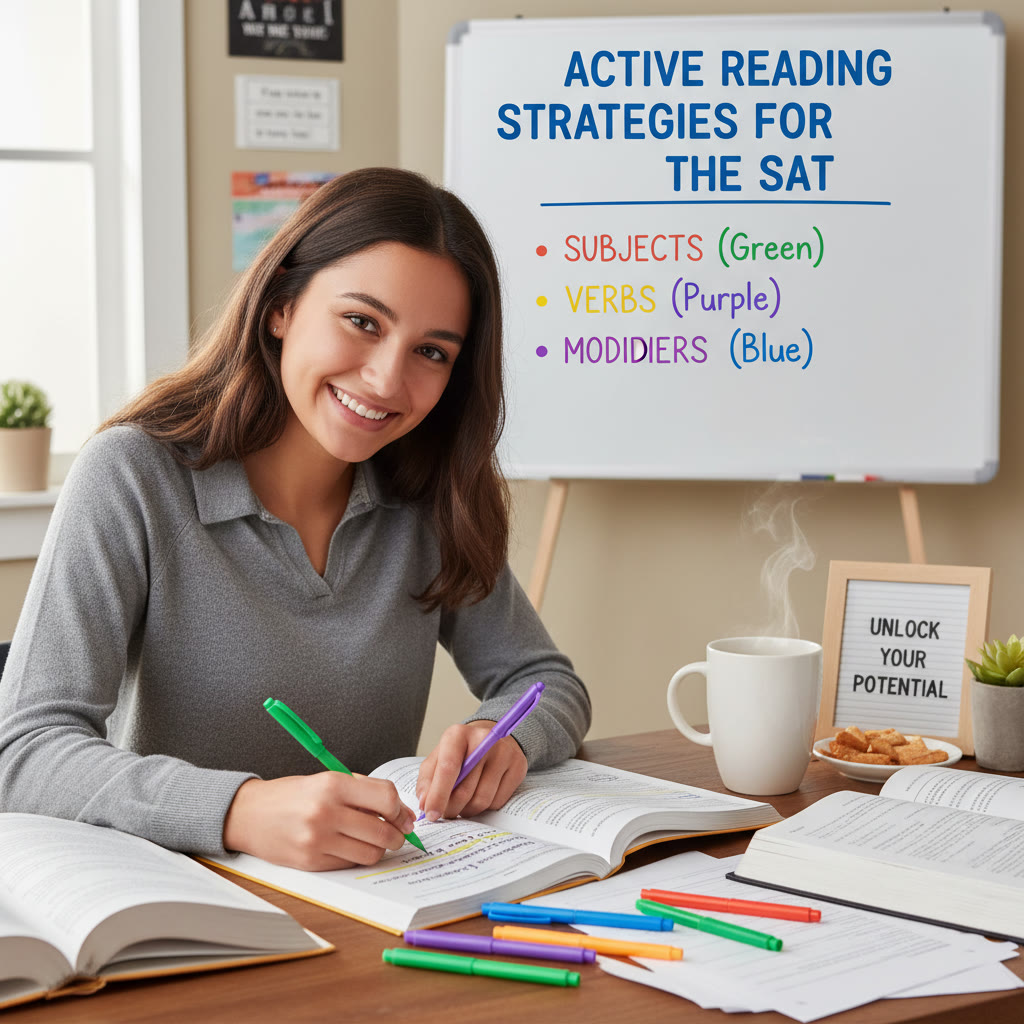Why these grammar rules matter (and why you can actually master them)
Walking into the SAT Writing and Language section can feel like stepping into a grammar scavenger hunt: editors’ red pens everywhere, sentences that look fine at first glance but hide a tiny mistake. The good news? The SAT does not test every rule in the English language. It cycles back to a handful of essentials again and again. If you know those essentials, you can find—and fix—most errors quickly and confidently.
This guide breaks down the most frequently tested grammar rules on the SAT in a friendly, practical way. You’ll get real examples, quick tricks to spot problems, a cheat-sheet table of signal words, and a study plan to practice efficiently. If you ever feel stuck, Sparkl’s personalized tutoring can offer tailored 1-on-1 guidance, expert tutors, and AI-driven insights to focus your practice where it matters most.
How the SAT tests grammar: context over rules
One thing to remember: the SAT tests grammar inside passages. It rarely asks about an isolated sentence without context. That means you’ll often make decisions based on clarity, tone, and logical relationships, not only isolated rule memorization. The test rewards answers that make a passage clearer, more concise, and more correct.
Three guiding questions to ask on every question
- Does this change improve clarity or precision?
- Is the sentence grammatically correct under standard written English?
- Does the choice maintain a consistent tone and structure with the surrounding sentences?
Top grammar rules you’ll see again and again
Below are the rules that appear most frequently. For each rule you’ll find: a short explanation, common signal words or structures that typically indicate a problem, an incorrect vs. correct example, and a quick test-taking tip.
1. Subject–Verb Agreement
Rule: A verb must agree with its subject in number (singular or plural). The trap on the SAT often comes from long intervening phrases, collective nouns, and subjects joined by ‘and’ vs. ‘or’.
Signals: ‘each’, ‘every’, ‘either/or’, ‘neither/nor’, prepositional phrases (of, among, with), and intervening clauses.
Incorrect: The list of books are on the table.
Correct: The list of books is on the table.
Why: The subject is ‘list’ (singular). ‘Of books’ is just extra information.
Tip: Identify the real subject and ignore intervening words. For constructions with ‘or’ or ‘nor’, make the verb agree with the noun or pronoun closest to it.
2. Pronoun Agreement and Reference
Rule: Pronouns must agree in number and gender with their antecedents, and every pronoun should clearly refer to a specific noun.
Signals: Vague references (‘it’, ‘they’) where multiple nouns are candidates; pronouns that disagree with collective nouns.
Incorrect: When the students finished the experiment, they turned in the report to the teacher who had supervised it.
Correct: When the students finished the experiment, they turned in the report to the teacher who had supervised them.
Why: ‘Them’ clearly refers back to ‘the students’; ‘it’ would be ambiguous (does ‘it’ mean the experiment or the report?).
Tip: Replace the pronoun in your head with the noun to see if it still makes sense. If more than one antecedent is possible, rewording is usually required.
3. Pronoun Case
Rule: Use subject pronouns (I, he, she, we, they) in subject positions and object pronouns (me, him, her, us, them) in object positions.
Signals: Pronouns near conjunctions (“Mary and I” vs. “Mary and me”); tricky constructions after prepositions.
Incorrect: The teacher gave the award to Sara and I.
Correct: The teacher gave the award to Sara and me.
Why: The pronoun is the object of the preposition ‘to’.
Tip: Drop the other noun and see which pronoun fits: ‘The teacher gave the award to me’ (not ‘to I’).
4. Verb Tense and Sequence
Rule: Maintain logical and consistent tense relationships. Past actions that happened before other past actions often use the past perfect.
Signals: Time markers like ‘already’, ‘previously’, ‘recently’, and clauses using conjunctions (when, before, after).
Incorrect: By the time she arrived, the class dismissed.
Correct: By the time she arrived, the class had been dismissed.
Why: The dismissal happened before her arrival; past perfect shows that order.
Tip: Ask: what happened first? If one past action clearly precedes another, consider past perfect.
5. Parallelism
Rule: Items in a list or series, and coordinate grammatical structures, should use the same grammatical form.
Signals: ‘and’, ‘or’, lists separated by commas, correlative conjunctions (both…and, not only…but also).
Incorrect: The coach asked the players to run, stretching, and that they hydrate frequently.
Correct: The coach asked the players to run, to stretch, and to hydrate frequently.
Why: The corrected sentence uses three infinitive phrases for a consistent list.
Tip: Put items side-by-side. If one starts with ‘to’ and another doesn’t, balance them.
6. Modifiers (Dangling and Misplaced)
Rule: Modifiers must be placed next to the words they modify. Dangling modifiers leave readers unsure what’s being modified.
Signals: Introductory phrases and participial phrases at the start of sentences; long distances between modifier and target.
Incorrect: Starting the engine, the fog made the road look like a river.
Correct: Starting the engine, she noticed that the fog made the road look like a river.
Why: In the incorrect sentence, it sounds like the fog started the engine. The corrected version names the person who started the engine.
Tip: Ask: who or what is doing the action in the introductory phrase? If it’s not clear, the modifier is misplaced.
7. Commas and Comma Splices
Rule: Use commas to separate items in a list, after introductory elements, and around nonessential information. A comma splice occurs when two independent clauses are joined by just a comma.
Signals: Two clauses joined by a comma with no conjunction; names or clauses set off by commas.
Incorrect (comma splice): She wanted to major in biology, she enrolled in an advanced course.
Correct (use semicolon or conjunction): She wanted to major in biology; she enrolled in an advanced course.
Also correct: She wanted to major in biology, so she enrolled in an advanced course.
Tip: If you find two independent clauses, use a semicolon, a period, or add a coordinating conjunction (for, and, nor, but, or, yet, so).
8. Semicolons and Colons
Rule: Use a semicolon to link two closely related independent clauses. Use a colon to introduce a list, explanation, or quotation after an independent clause.
Signals: Two independent clauses with a tight relationship; lists introduced by a complete sentence.
Example: She had one guiding rule: always ask questions.
Example: He loved three things: coffee, morning runs, and lively debates.
Tip: If the second clause explains or amplifies the first, a colon often works. If they’re just closely related statements, think semicolon.
9. Comparisons
Rule: Comparisons must be logically and grammatically parallel—don’t compare two things to a third implicitly.
Signals: Words like ‘than’, ‘as’, ‘more’, ‘less’, ‘similar to’, and comparative pairs.
Incorrect: The novel is more interesting than any book on my shelf because of its characters.
Correct: The novel is more interesting than any other book on my shelf because of its characters.
Why: ‘Any other book’ completes the comparison. The incorrect version suggests the novel is being directly compared to ‘any book on my shelf’ including itself.
Tip: Make sure your comparison has two clear, comparable items. Add ‘other’ when comparing one item to the rest of a group.
10. Word Choice and Idioms
Rule: The SAT tests common idiomatic expressions (agree with, different from, responsible for), and it checks for precise word choice (affect vs. effect, fewer vs. less, lie vs. lay).
Signals: Preposition + verb combinations and commonly confused word pairs.
Incorrect: She was able to, less than anyone else, endure the long training.
Correct: She was able to, fewer than anyone else, endure the long training. (Use ‘fewer’ with countable nouns.)
Tip: Memorize a small list of common idioms and confusing pairs. When in doubt, replace the phrase with simpler wording to test clarity.
Quick-reference table: top rules, signals, and quick fixes
| Rule | Signal words/structures | Quick fix |
|---|---|---|
| Subject–Verb Agreement | each, every, of, either/or, neither/nor | Find the subject; ignore intervening phrases |
| Pronoun Agreement | it, they, this, that (ambiguous antecedents) | Replace pronoun with the noun; ensure clarity |
| Parallelism | and, or, both…and, not only…but also | Match grammatical forms in lists |
| Modifiers | Introductory phrases, participles | Place modifier next to the word it describes |
| Comma splices | Independent clause, independent clause | Use semicolon, period, or conjunction |
| Idioms & word choice | preposition + verb combos; affect/effect | Memorize common idioms and prefer clarity |
Practical strategies for the test day
Rules are useful, but strategy wins on test day. Here are practical habits that save time and boost accuracy.
Strategy 1 — Read for meaning first
Because the SAT cares about clarity and tone, read the sentence in context. Ask whether the change improves the passage, not whether it only sounds correct in isolation.
Strategy 2 — Predict before you look at choices
Quickly think of what would make the sentence correct. Then scan choices for your predicted fix. This avoids traps and wordy distractors.
Strategy 3 — Eliminate obviously wrong answers fast
Many multiple-choice options on the SAT are designed to distract. If an option creates a comma splice, changes meaning unnecessarily, or introduces ambiguity, toss it and move on.
Strategy 4 — Use substitution and rephrasing
If a pronoun or verb form is tricky, rephrase the sentence with the actual noun or in a simpler construction. Often the correct answer will be the clearest, most direct version.
Strategy 5 — Watch for consistent style
If a passage uses formal academic tone, avoid conversational fixes; if it’s a lively narrative, a slightly informal phrasing might be better. The SAT looks for consistency, not just grammar in a vacuum.
Practice checklist: drill these until they’re automatic
- Identify subjects and verbs in short sentences; then in long sentences with phrases inserted.
- Find and fix pronoun reference problems — especially vague ‘it’ and ‘they’.
- Convert series to parallel structures (practice with lists of verbs, nouns, and clauses).
- Rewrite sentences with introductory modifiers until the subject is clear.
- Distinguish between semicolons and colons with short practice drills.
- Memorize 20–30 common idioms and confusing word pairs and quiz yourself weekly.
A simple 8-week study plan (tailor it based on need)
This plan assumes you’ll spend about 4–6 hours a week on Grammar/Writing practice. If you have limited time, compress the plan; if you have more time, spread it out.
Weeks 1–2: Foundations
- Focus: Subject–verb agreement, pronoun agreement, and pronoun case.
- Practice: 20 targeted practice questions per session; review explanations thoroughly.
- Goal: Be able to identify the true subject and antecedent quickly.
Weeks 3–4: Sentence structure and modifiers
- Focus: Dangling/misplaced modifiers, run-ons, fragments, comma splices.
- Practice: Rewrite 10 sentences per session to correct modifier placement; do mixed drills for punctuation.
- Goal: Place modifiers clearly and fix punctuation errors without overthinking.
Weeks 5–6: Parallelism, comparisons, and idioms
- Focus: Parallel structure and comparisons; memorize idioms and confusing word pairs.
- Practice: Create your own lists and compare several sentence versions; do 25 mixed questions per session.
- Goal: Make parallelism instinctive and sharpen idiom recall.
Weeks 7–8: Mixed practice and timing
- Focus: Full passages; timing; adaptability.
- Practice: Take mixed sets under timed conditions; review errors to find patterns.
- Goal: Translate rule knowledge into rapid, correct decisions under time pressure.
If you want to accelerate progress, Sparkl’s personalized tutoring can help focus those eight weeks: expert tutors provide 1-on-1 guidance, tailor study plans to your weak spots, and use AI-driven insights to track your improvement so every minute is efficient.
Common pitfalls students report (and how to avoid them)
Here are real mistakes students make and practical fixes you can start using right away.
Pitfall: Over-correction
Sometimes students change an answer that was already correct because another choice ‘sounds better.’ Fix: If your predicted correction matches one of the choices and the passage’s meaning and tone are preserved, stick with it. If not, re-evaluate.
Pitfall: Rushing through pronoun questions
Students often select vague pronouns because they read too quickly. Fix: Briefly underline the pronoun and its possible antecedents; replace the pronoun with each noun mentally.
Pitfall: Confusing commas and semicolons
Commas and semicolons look similar on the page but serve different functions. Fix: If you see two independent clauses, immediately think semicolon or conjunction. If a clause is nonessential, surround it with commas.
Short practice drills you can do in 10 minutes
- Spot the subject and verb in five complex sentences.
- Rewrite five sentences that begin with participial phrases to name the subject immediately.
- List 10 idioms from memory and use each in a short sentence.
- Convert five lists to parallel structure (mix nouns, verbs, and clauses).
Example problems with step-by-step thinking
Seeing the thought process matters more than memorizing rules. Here are two walk-throughs.
Example 1 — Pronoun reference
Sentence: After the committee reviewed the applications, they decided to postpone the decision.
Question: Who does ‘they’ refer to?
Think: Two nouns exist: ‘committee’ (singular collective) and ‘applications’ (plural). Which makes sense as the agent of ‘decided’?
Answer: The committee. So ‘they’ is ambiguous because ‘committee’ is singular. Reword to avoid confusion: ‘After the committee reviewed the applications, it decided to postpone the decision.’
Example 2 — Parallelism
Sentence: The professor encouraged students to read more, write carefully, and that they should participate in discussions.
Think: The first two verbs are infinitives (‘to read’, ‘write’ — though ‘write’ should be ‘to write’ for balance), the third is a clause. Convert all items to the same form.
Correct: The professor encouraged students to read more, to write carefully, and to participate in discussions.
Final thoughts: precision, practice, and pacing
Grammar on the SAT rewards three things: accurate knowledge of a focused set of rules, efficient strategies for spotting problems, and steady practice under timed conditions. Build the habit of asking “Who is doing what?” and “Does this make the passage clearer?” and you’ll catch more errors faster.
Remember that improvement is cumulative. A few minutes of daily, targeted practice is better than a marathon the week before. If you’d like help tailoring that daily practice to your specific strengths and weaknesses, Sparkl’s personalized tutoring can provide targeted sessions, expert feedback, and AI-driven progress tracking so your work is always focused and effective.
Image ideas


Quick checklist to take into practice now
- Identify subjects and verbs in three sentences whenever you read.
- Underline each pronoun and ensure a single, clear antecedent.
- Convert any list you write into parallel structure before finalizing.
- When you see a comma, ask whether an independent clause follows; if so, check for splice.
- Practice one timed passage each week and review every missed question thoroughly.
Closing encouragement
Grammar is not a mystery—it’s pattern recognition. Learn the patterns the SAT cares about, practice with intention, and your confidence will grow. You don’t need to know every obscure rule; you need to know the rules that appear most often and how to apply them quickly. Keep a focused checklist, drill deliberately, and use targeted help when you hit a plateau. With clear strategies and steady practice, you’ll transform uncertainty into precision—and that’s the kind of progress that shows up on test day.
Good luck—and enjoy the satisfying click of a correct answer when grammar finally falls into place.














No Comments
Leave a comment Cancel